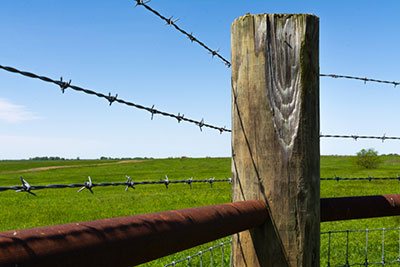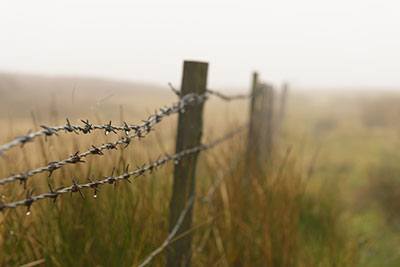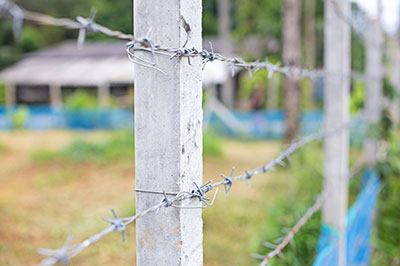Are you looking to keep your cattle safe from predators or curious onlookers? Installing a barbed wire fence can be an effective solution for ensuring that your herd is securely guarded.
We’ll go over all the steps needed to install a barbed wire fence to provide the extra protection and security your livestock needs. We’ll discuss the materials required, tools need, how to unroll the fencing, set up the posts, connect everything, and more!
By properly following these instructions you’ll have a sturdy and reliable barrier protecting your beloved cows in no time!
Take away key points:
- Building barbed wire fencing systems requires a little help to cut wire, and adjust the top or bottom wire
- You can choose among different post models to ensure the best one for your needs
- Follow our steps below to finish your progress effectively
Table of Contents
- Installing barbed wire fence: All you must know
- What makes a good barbed wire fence?
- How to install barb wire fence systems? A complete procedure
- Pre-step: Gathering necessary tools
- Step 1: Select the best location
- Step 2: Find the best barbed wire fence spacing and fencing posts
- Step 3: Mark the fence posts
- Step 4: Secure the first fence post with the barbed wire
- Step 5: Attach the fence wire tensioner to the fence post
- Step 6: Tighten the barbed wire
- Step 7: Staple the barbed wire
- Step 8: Repeat the process
- Can I use metal posts for the barbed wire fence?
- Extra tips & recommendations
- Frequently Asked Questions
- Summary
Installing barbed wire fence: All you must know
If you need to learn about fencing barbed wire techniques, appropriate locations, and other necessary tools to set up the barbed wire fence effectively, read our post below.
What makes a good barbed wire fence?

An ideal barbed wire fence is strong, durable, and cost-effective. It should be made of low-carbon wire with a zinc coating to protect it from rust and corrosion.
Additionally, reverse-twist barbed wire is an excellent choice for fencing in areas that experience high winds or other harsh weather conditions. The key to a good fence is also in the bracing, as this helps ensure the fence lasts longer.
How to install barb wire fence systems? A complete procedure
Generally, the process of installing barbed wires is quite simple. It involves the following steps:
– preparing the wire by unrolling it and positioning line poles at intervals of 7 to 10 feet
– marking the wood post place and using barbed wire to secure the first post
– attaching the masseurs and stapling the wires in place after proper positioning
– repeating this procedure for the remaining wires.
To understand this installation process better, let’s delve deeper into each step.
Pre-step: Gathering necessary tools
You’ll need different materials to build a barbed wire fencing system: high tensile barbed wire, hammer, wrench, staples, wire cutter, line tensioners, protective gloves.
Ensure you wear protective equipment – heavy-duty gloves, safety gloves, footwear, and similar gear to protect you from significant lacerations. However, you should team up with a friend for smoother operations and to set the wires correctly. The procedure is the following:
Step 1: Select the best location
To begin, create a plan for the placement of the fence posts and then determine the precise location of the barbed wire fence posts on your property.
Choose the appropriate spacing for the posts, and add wood posts fairly. The spacing should ideally be between 7 and 10 feet. You may add additional brace wire fence posts if needed, although it’s important to avoid using too many.

Step 2: Find the best barbed wire fence spacing and fencing posts
It is recommended to have 0.75 to 0.5 inches of the extra post height positioned below ground level. Before knotting the woven wire, ensure firmly secured posts.
You can either hammer or cement them into the ground. Both metal and wooden posts are acceptable to use for solid attachment and enough resistance.
The T-posts are an ideal option for wet ground, as they show much resistance to the weather elements. If you live in a flat country, these parts are also advantageous.
However, the T-posts might be pretty weak if the cattle press on the fence, especially, if it’s an old fence. But, they will work better with wood posts interspersed for more stability.
Our further instructions specifically refer to wooden ones for the fence line and ideal wire spacing.
Step 3: Mark the fence posts
Indicate on each post where the wire should be placed. For more convenience, mark the intermediate posts at the same height as the starting posts or corner posts. You should give yourself a couple inches to so fix the uneven soil issues, and deice the place and height of the post.
Sometimes you must gather rocks to make a rock basket for a better fence post or an anchor for the future line in the low spot.
Step 4: Secure the first fence post with the barbed wire
Begin attaching the first layer of barbed wire to the starter post, starting from the bottom and at an appropriate height. To maintain tension, you should wrap the wire around the post, the next two posts, then the fourth or fifth post, and loop it back, wrapping it around the post four or five times. Slowly unroll the barbed wire until you reach the fence corner or end post.
Step 5: Attach the fence wire tensioner to the fence post
Using the ratchet handle, begin to pull the wire tight and secure it with a staple. Continue this process until you reach the next post or corner.
The fence wire tensioner helps to keep your barbed wire fencing taut and secure. It will also stretch the wire to ensure it will stay tight, at a consistent height, and ensure strong wires.
Step 6: Tighten the barbed wire
Using a wrench, turn the nut on the tightener clockwise to tighten the barbed wire. To avoid injury, only use one hand when bending the wire. You can also decide how many wires you will add, and ensure you stretch wire to the post securely for various seasons. You will also fix the loose end if any, and keep the wires tight.
Step 7: Staple the barbed wire
Once the first strand of barbed wire has been attached to the end posts, continue this process. Staple the wire to each middle post separately. Begin at the top and continue your work down.
Keep the height consistent at each fence post when stringing barbed wire. Although you should allow some flexibility, you should staple the wire as tightly as possible to the fence posts. You will also ensure as much anchor quality as possible for various extreme cases.
Step 8: Repeat the process
For custom fencing of additional wires, repeat the installation process outlined above. It is important to ensure that the wire remains taut throughout the process. you will ensure more braces, enough diameter, and good ground to hold posts securely. Set posts too keep the wires optimal.
Can I use metal posts for the barbed wire fence?
Yes, you can use the metal posts for building a barbed wire fencing system.
When using metal posts, it is important to make sure they are properly secured in the ground.
Posts should be spaced at least 12-15 feet apart and driven into the ground with a post driver or sledgehammer until they are firmly in place. The posts should also be treated with a rust-resistant coating to ensure that they last longer and remain secure.
Once the posts are in place, attach the barbed wire to them using fencing staples or clips. Make sure that you use at least two staples per post and check periodically to ensure that the barbed wire is still securely attached.
Extra tips & recommendations

Before building the brace wire fence, it’s crucial to double check your measurements. You should make sure each fence post has a proper position in angle. Once the fence is constructed, it will be difficult to move the posts.
When selecting the positions for the posts, consider the macroclimate. Steel pillars are ideal for use in high humidity, or extreme weather conditions, as they are incredibly durable, reliable, and sturdy.
Although they are more costly, they provide exceptional value for their price. Even though wood posts are made of hardwood and are treated with advanced preservation chemicals, they are not as durable as metal ones.
Frequently Asked Questions
How far apart are fence posts for barbed wire?
The typical fence posts for barbed wire are 10-12 feet. They also use 3 to 5 strand barbed wire fence spacing.
Do you need wood posts for the barbed wire fence?
Yes, you can wooden posts, but you can also use metal or steel posts, depending on your needs.
How many strands of barbed wire for cattle?
You need between 4-strand barbed wire fence spacing and 6-strand barbed wire fence spacing.
How do you calculate barbed wire for a fence?
One roll of wire is equal to a quarter mile, or 1,320 feet of fencing.
How to install barbed wire on top of the fence?

To install the top wire, here are the steps you should take:
– Put on protective clothing, including thick boots and gloves before handling barbed wire. It’s also important to wear an eye covering, as the sharp edges of the barbs can cause injury if not handled properly.
– Unroll the barbed wire to prepare it and place line poles 7 to 10 feet apart, adjusting distance as necessary.
– Using the top wire as a straight first line, install line posts (wood or steel) 15 to 20 feet apart, adjusting the distance as necessary.
– Securely attach one end of your razor wire to a corner post brace and stretch it along the line posts until you reach the other end of your fence line.
– Securely attach the razor wire to each post with staples or clips designed for this purpose, making sure that there are no gaps between posts where someone could slip through unnoticed.
– Make sure that all wires are taut and secure before moving onto another section of your fence line.
Summary
When building your wire fences, you will decide how much pressure they can resist to prevent wildlife traffic and protect your cattle.
The barbed wire can be installed on nearly any terrain or uneven ground. You can use smaller posts, brace posts, and similar parts to ensure the best system. Follow the instructions above the get the best fencing system.
